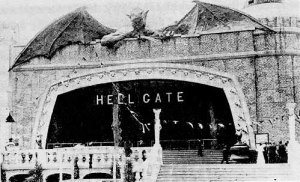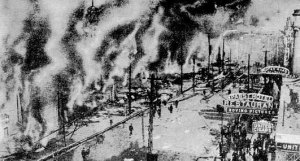The Dreamland Fire was one of the few historical liberties taken in Piper Houdini: Apprentice of Coney Island. Though the devastating fire happened almost exactly as depicted in the novel, the fire occurred fifteen years before the book’s main events.
 In spite of its many draws, Dreamland always struggled to compete with Luna Park, which was better managed. In preparation for its 1911 season, many changes were made. Samuel W. Gumpertz (later director of the Ringling Brothers and Barnum & Bailey Circus) was put in the park’s top executive post. The buildings, once all painted white in a bid for elegance, were redone in bright colors. On the night before opening day, a concession called Hell Gate, in which visitors took a boat ride on rushing waters through dim caverns, was undergoing last-minute repairs by a roofing company owned by Samuel Engelstein. A leak had to be caulked with tar. During these repairs, at about 1:30 in the morning on May 27, 1911, the light bulbs that illuminated the operations began to explode, perhaps because of an electrical malfunction. In the darkness, a worker kicked over a bucket of hot pitch, and soon Hell Gate was in flames.
In spite of its many draws, Dreamland always struggled to compete with Luna Park, which was better managed. In preparation for its 1911 season, many changes were made. Samuel W. Gumpertz (later director of the Ringling Brothers and Barnum & Bailey Circus) was put in the park’s top executive post. The buildings, once all painted white in a bid for elegance, were redone in bright colors. On the night before opening day, a concession called Hell Gate, in which visitors took a boat ride on rushing waters through dim caverns, was undergoing last-minute repairs by a roofing company owned by Samuel Engelstein. A leak had to be caulked with tar. During these repairs, at about 1:30 in the morning on May 27, 1911, the light bulbs that illuminated the operations began to explode, perhaps because of an electrical malfunction. In the darkness, a worker kicked over a bucket of hot pitch, and soon Hell Gate was in flames.
 Dreamland, the largest of the amusement parks, was wiped out and about four blocks adjoining, covered with booths, restaurants, hotels, moving picture theaters, and resorts of various types, were destroyed. The fire broke out at 2 a.m. and was not under control until three hours and a half later. In all about 200 buildings were burned and perhaps 2,000 persons — concessionaires and employees — were turned into the streets homeless and penniless. No human lives were lost but the financial loss amounted to between $2,000,000 and $3,000,000. The burned area represented nearly a third of the entire amusement city, all of which would undoubtedly have gone in the teeth of a strong wind but for the fact that Coney Island, with a high pressure water system especially designed for fire protection, was better guarded against a disaster of this kind than any other similar resort in the world.
Dreamland, the largest of the amusement parks, was wiped out and about four blocks adjoining, covered with booths, restaurants, hotels, moving picture theaters, and resorts of various types, were destroyed. The fire broke out at 2 a.m. and was not under control until three hours and a half later. In all about 200 buildings were burned and perhaps 2,000 persons — concessionaires and employees — were turned into the streets homeless and penniless. No human lives were lost but the financial loss amounted to between $2,000,000 and $3,000,000. The burned area represented nearly a third of the entire amusement city, all of which would undoubtedly have gone in the teeth of a strong wind but for the fact that Coney Island, with a high pressure water system especially designed for fire protection, was better guarded against a disaster of this kind than any other similar resort in the world.
The fire was discovered in Hell Gate’s tarred scaffoldings. Twenty minutes after a frightened watchman had turned in three alarms, one after another as fast as his thumb could press the key, all Dreamland, ten acres of gaudy, closely packed buildings, was one great blaze. The flames, urged by a strong wind, were visible for nearly 15 miles. Close to Hell Gate was the Bostock animal show, and nearer yet the infant incubator, a charity nursery in which were six wee infants and their attendants. The children were taken out in their little glass houses and rushed out of danger by the police. Then came the work of taking out animals, a costly collection including several dangerous man-eaters. The animals were in a panic. Their roaring could be heard above the crackling of the flames and the throbbing of the engines.
The trainers lost no time. While policemen with drawn revolvers stood at the entrance to guard the crowd in the streets against any beasts that might escape, the attendants drove their charges from the cages down the runways into the emergency vans which are always ready. All went well until the transfer was nearly concluded. Then the biggest of the lions, in a panic, broke from his bonds, smashed his way through the barriers and leaped into the street already packed by a throng of spectators. He dived straight into the middle of the throng.
Consternation seized the multitude and the crowd pushed pell-mell in all directions in panic. A mounted policeman came at the crouching beast in the center of the wide avenue with drawn revolver. Twice he shot and twice missed the lion backing away from the noise of the explosions. Then six mounted policemen lined up in front of the crowd and opened a fusilade. Backing away, snarling and leaving a trail of blood from many wounds, the king of the jungle made his way across the avenue into the dark wooden tunnels of the “Rocky road to Dublin.” In a black corner beneath painted scenery of equatorial Africa, he made his last stand. Three final volleys were required to finish him and he sand to the ground riddled like a sieve. To make sure that he was dead one of the policemen pulled down a fire axe from the wall and knocked the skull in two.
As soon as the crowd was sure the lion was dead they rushed in and literally tore the carcass to pieces for souvenirs. The first men got the tasseled tail, the next three divided the long mane, and fifty men fought among themselves for the glory of possessing one of his teeth.
Sixty of the 150 animals were left to die by fire. Almost before the firemen had their hose connected to the high pressure taps along the street the great Dreamland tower, with its glare of many thousand electric bulbs fell into the lake and the fire swept on beyond the bounds of Dreamland to the horde of little booths and concessions which lined the narrow streets beyond. The Dreamland pier, jutting far out into the ocean, with its broad burden of stands and booths, was swept clean to its steel foundations. The only casualties, reported by the police were three persons overcome by the smoke, one a fireman and the other two nurses in the incubator hospital.
All three were revived without difficulty.
Had the fire started two hours earlier when the crowd of sightseers thronged the concessions the disaster would have been an appalling one. Dreamland closed up shortly after midnight and the streets were nearly deserted by two o’clock. About 200 employees were still in Dreamland but all escaped.
The fire was visible all over Brooklyn and lower New York and before three o’clock the rapid transit trains were bringing a throng of sightseers while the boulevards were crowded with automobiles bound Coneyward.
The streets of the island are not wide and the incoming crowd interfered seriously with the work of the firemen and swamped the police reserves.
Coney Island had always been a frequent sufferer by fire. The most disastrous blaze was one that started in Steeplechase park in July, 1907. It swept some 35 acres clean and caused a loss of $1,500,000.
Another occurred on July 8, 1908, which destroyed two hotels with a loss estimated at $200,000.
The only animals removed from Ferrari’s shows were two lions, a leopard, two llama, two monkeys and six ponies. The others, including six lions, 24 monkeys, eight leopards, a baby elephant, ponies, bear cubs and llamas were so terrified by the flames that they refused to let their keepers drive them into 15 wheeled cages kept on hand for shifting them. Then the lights went out and the fire crept so close that the efforts to save them had to be abandoned. A few were shot but in most cases there was no time even for this and the majority died, their cries sounding above the roar of the flames.
In addition to “Black Prince,” the lion that died pierced by a hundred bullets, a leopard and a baboon escaped from their cages and ran among the crowd. Policemen shot them both before they could injure anyone.
Source: http://www.westland.net/coneyisland/articles/dreamlandfire.htm
Source: http://www3.gendisasters.com/new-york/8052/coney-island-ny-disastrous-fire-may-1911






